2018 Activity Report
September Activity Report
30 September 2018
Global Japan Office Coordinator
HARA Masaki
【Summer School】
The summer vacation came to an end, and the new semester began. In September, exchange students from TUFS usually come to Lviv. This year, three second year students, MARUSHIMA Riko, SHIGEMITSU Mikako, IDANI Ami and one fourth year student, KOSHIZUKA Naoko, participated in the three-week summer school program.
At summer school, students take Ukrainian language classes at the university, attend courses on culture and history, and participate in workshops including traditional “motanka” doll-making classes. At the Ukrainian cooking class, held in a restaurant in the city, the students made mushroom soup and deruny (potato pancakes). The students also observed many classes taught at the Centre for Culture and Creativity for Children and Youth in Halychyna (Galicia). They also attended a concert by Fujiko Hemming with professors from the University of Lviv.
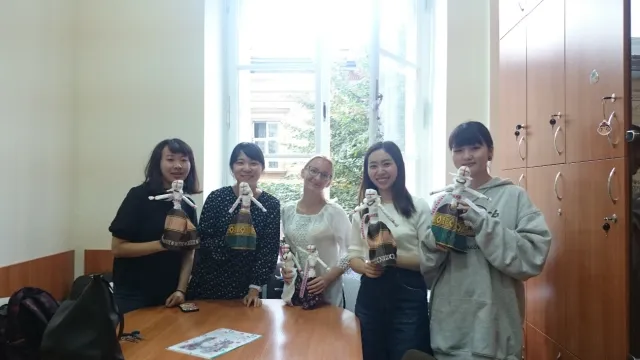
【Information Session with the Embassy of Japan】
Some visitors came from the Embassy of Japan in Ukraine.
They held a lecture on Japanese climate and culture, and an information session on the national scholarship exchange student exam. The students, even the first years who had only just entered the university, actively participated.
The lecture talked about “wakon yōsai” (Japanese spirit with Western learning) and comparisons between Ukraine and Japan. In particular, the discussion on how “Ukraine has no tunnels from Kyiv to Dnipro, but it is unbelievable in Japan to not have any tunnels across this amount of distance,” left an impression (Dnipro is in Southern Ukraine, from which the distance to Kyiv is 600km).
The exam is a highly competitive hurdle, but I think it is wonderful that this path exists (what about a national scholarship exchange program to Ukraine though?). I hope the students study hard and step up to the challenge.
(More information on this event can be found on the Embassy of Japan in Ukraine’s Facebook page).
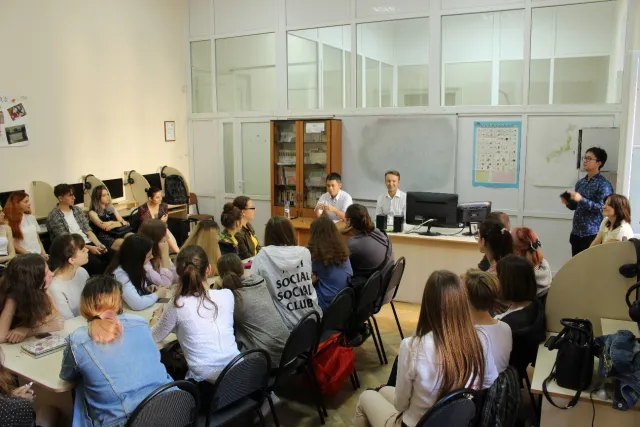
【Winter is Here!】
Just as the TUFS students left, Lviv became cold, and the climate is similar to winter in Tokyo. From now on the days will alternate between being cold and warm until it finally becomes winter.
August Activity Report
31 August 2018
Global Japan Office Coordinator
HARA Masaki
【Summer Vacation】
Since it is still summer vacation, there were no classes this month either, so once again I will report on a town near Lviv.
【House of Prince Ostrozky】
This month I would like to talk about the rulers of Ukraine in the early modern period, the Ostrozky House (Князі Острозькі).
The Ostrozky House is a noble family originating from a town in northeast Ukraine called Ostroh (Острог, now a city located in Rivne Oblast). Their ancestors include the Grand Prince of Kyiv and the King of Ruthenia, Danylo Romanovych (Daniel of Galicia). King Daniel was the architect of Lviv. According to family tradition, King Daniel and the founder of the House of Ostrozkyi, Danylo Ostrozsky, were the same person (research has shown that Danylo Ostrozsky was in fact the grandchild of Daniel of Galicia). The House of Ostrozky reigned as magnates of the Polish-Lithuanian Commonwealth, and made great contributions to Ukrainian society as the guardians of orthodoxy and Ukrainian culture. However, the family line came to an end in 1620. The family’s heritage was passed on to the House of Zasławski (Князі Заславські), which came to an end in 1682, and so the family died out.
【Lviv】
Kostiantyn Vasyl Ostrozsky (Костянтин-Василь Острозький, 1526/27-1608) was a magnate that was known for establishing a university (theological school) and printing press in Ostroh. The University of Lviv’s museum has positioned the university as the “point of fruition”, as it boasts both the Eastern culture of Byzantine inherited from Kostiantyn Vasyl Ostrozsky, and the Western culture brought by the Jesuits.
This year, Lviv’s Monastery of St. Onuphrius, which was donated by Kostiantyn Vasyl Ostrozsky, will reach its 500th anniversary. Ivan Fedorov (also transliterated as “Fyodorov”), who published the first complete East Slavic translation of the bible with the assistance of Kostiantyn Vasyl Ostrozsky, also lived in Lviv and was involved in translating and publishing work at the Lviv Dormition Brotherhood.
There are also House of Zasławski churches in Lviv. The grounds of the Lviv National Vasyl Stefanyk Scientific Library of Ukraine used to be the territory of one church, which is now being used as an archive by the Calced Carmelites St. Agnes Church and Monastery that the Zasławski family contributed to. They also contributed to the construction of the Discalced Carmelite Church and Monastery (now the Church of St. Michael the Archistrategos). In addition, they also carried out a lot of support as the guardians of the Uniate Churches (now known as Ukrainian Greek Catholic Churches).
【Stare Selo】
The house of Ostrozsky owned a lot of land in what is now the Lviv Oblast. Among these territories is the Stare Selo Castle (Старосільський замок), the largest (2 hectares) fortress in the Lviv Oblast, which was built in the golden age (the late 16th century) of this house in Stare Selo (Старе Село), a village on the outskirts of Lviv. It is often included as part of the “Golden Horseshoe of Lviv Region”.
The castle was built from 1584-1589 in the era of Kostiantyn Vasyl Ostrozsky. It was designed as a renaissance fortress by an architect brought in from Italy, Ambroży Przychylny (also known as Vaberene Nutclauss). In 1642, Wladysław Dominik Zasławski (Владислав Домінік на Острозі Заславський, 1616-1656) commissioned some alterations. In 1648, the castle was attacked and destroyed by Cossack uprisers, but Wladysław Dominik Zasławski rebuilt it as a solid and splendid castle influenced by Mannerism and Baroque. He lived out the rest of his life and passed away in this castle. After the second reconstruction, the castle survived not only the Cossack attacks, but also attacks from the Crimean Khanate and the Ottoman Empire. Wladysław Dominik Zasławski was a general in the Polish army who suffered a great defeat in a battle with the Cossacks, after which he was exclusively referred to by the ridiculous nickname “duvet”, but I don’t think he completely lacked military sense.
Only the ramparts and towers remain today, but you can see the characteristics of a triangular/pentangular bastion fort, and the whirlpool pattern that was popular for decorations in the early modern period in Western Ukraine.
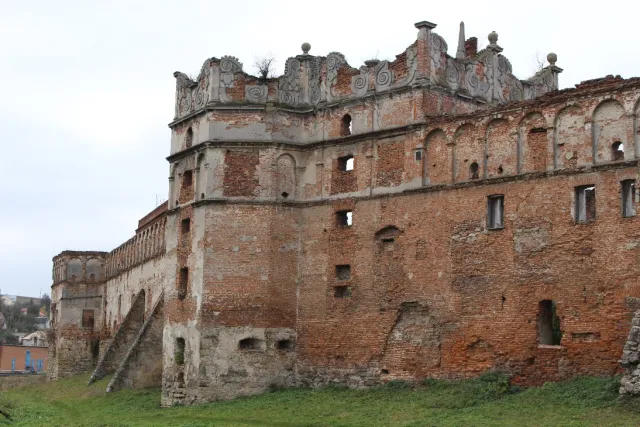
【Dubno】
In light of a family revolt over the estate of his father, Kostiantyn Vasyl Ostrozsky’s son, Janusz Ostrozsky (Януш Васильович Острозький, 1554-1620), created the “Majorat of Ostroh” (Острозька ординація), which banned the distribution of property, in 1609. Dubno (Дубно, now a city in the Lviv Oblast) became the capital of this.
He rebuilt his grandfather’s stone castle into a solid bastion fortress with high earthen walls and deep moats. The main section is an irregular shape, and looks as if one corner of a triangle was cut off by a river. A church and a monastery from the same era, and a castle gate from the Zasławski era still stand today.
This castle, Dubno Castle, became famous as the setting for the final battle in “Taras Bulba”, a historical novella by Nikolai Gogol. In the novel, the beautiful young woman that Taras’s son Andrii falls in love with was based on Halshka Ostrozska (Гальшка Острозька), and her father, “the voivode of Kovno (Kaunas)” (Воевода ковенский), was based on Kostiantyn Vasyl Ostrozsky, who was “the voivode of Kyiv” (Воєвода київський).
【Directions】
The Monastery of St. Onuphrius is located about 10 minutes north along the train tracks past Old Rynok (Старий Ринок), which was the center of the region during Daniel of Galicia’s era. There you will find the base of the castle’s promontory. You can either catch the number 6 tram or walk there. The Scientific Library of Ukraine is near the University of Lviv.
Stare Selo Castle is right in front of the Stare Selo Railway Station. It takes a little under an hour on the train heading to Khodoriv (Ходорів) from Lviv Suburban Railway Station (Приміський вокзал станції Львів).
Dubno is a little over an hour away by express train, but since there are not many trains or buses, it is hard to make a day trip there. It is probably best to go there on an evening train and spend the night, then return on the last train at 14:21 the following day. The castle is in an urban area away from the railway station, which can be reached by bus.
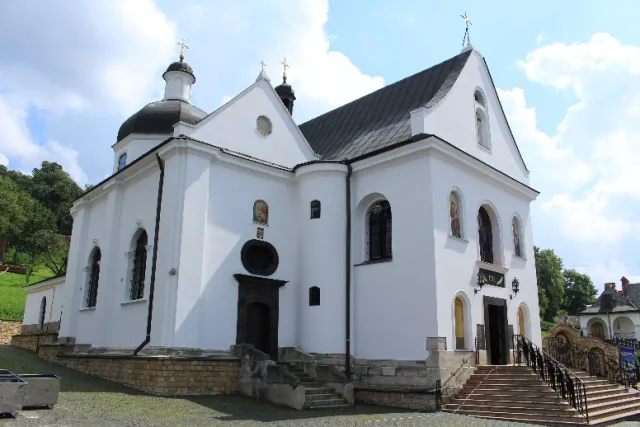
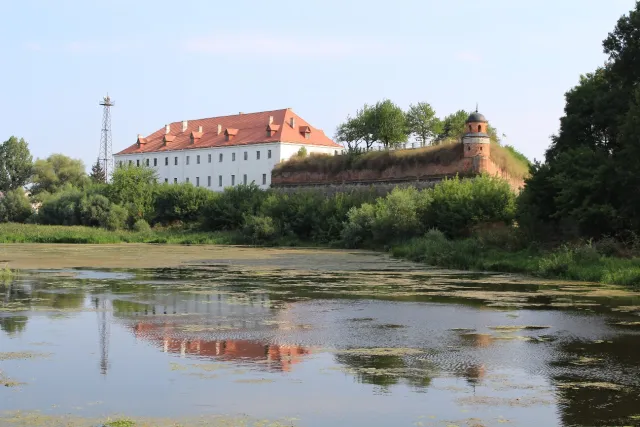
【References】
Дзярнович О., Рагаускене Р., Тесленко І., Черкас Б. Князі Острозькі. Київ: Балтія-Друк, 2015.
Гаврилюк І. Владислав Домінік Заславський (1616–1656 рр.): магнат, політик, воєначальник // Спеціальні історичні дисципліни: питання теорії та методики. Збірка наукових праць / Відп. ред. Г. В. Боряк; Упорядники: В. В. Томазов, І. К. Хромова. Київ: НАН України, Інститут історії України, 2013. Число 22–23. С. 83–110.
Мацюк О. Я. Замки і фортеці Західної України. Мандрівки історичні. Львів: Центр Європи, 2013. С. 17–22.
Палков Т. Західна Україна. Частина II. Львів: Ладекс, 2011. С. 35–36.
Яковенко Н. М. Українська шляхта з кінця XІV до середини XVІІ століття. Волинь і Центральна Україна. Видання друге, переглянуте і виправлене. Київ: Критика, 2008 (вперше видано 1993).
Войтович Л. В. Княжа доба: портрети еліти. Біла Церква, 2006.
Кралюк П. Таємний вояж Гоголя // Газета «День» [https://day.kyiv.ua/uk/article/ukrayinci-chytayte/tayemnyy-voyazh-gogolya] (2018年8月5日閲覧、以下同じ).
Старе Село // Замки і храми України [https://www.castles.com.ua/stselo.html].
Дубно//Замки і храми України [https://www.castles.com.ua/dubno.html], [https://www.castles.com.ua/dubno2.html].
July Activity Report
31 July 2018
Global Japan Office Coordinator
HARA Masaki
【Summer Vacation】
At the University of Lviv, the workshops and graduation ceremonies finish by the first half of July, and then the summer vacation begins. Many students come from areas outside of Lviv, and most of them return home during this time. The new academic year begins in September. While Japan experiences heat waves this time of year, in July in Lviv it rains so much that it might as well be rainy season.
【The Golden Horseshoe】
Since it is summer vacation, I don’t have any university-related topics to report on this month, so I will write about a town near Lviv.
There are many scenic and historic places in Lviv and the Lviv Oblast. These can be broadly categorized as natural wonders or historical heritage sites. For the latter, there is a sightseeing route called “The Golden Horseshoe of Lviv Region” (Золота підкова Львівщини). This month, I will report on one of the most well-known castles on this route, Zolochiv Castle, which was the castle of Jan III Sobieski (1629-1696) who is famous for his part in the Battle of Vienna.
【Zolochiv】
Zolochiv is a city of 24,000 people located 66 km east of Lviv. It was also the site of Radeche, an ancient Ruthenian city in the 12th century. The name “Zolochiv” first appeared in historical texts from the early 15th century. In 1523, Zolochiv became a city under the Magdeburg rights.
Zolochiv underwent rapid development from 1552-1740, which was the period it was owned by the magnate of the House of Sobieski. It is said that the House of Sobieski is a family that came from the Lublin region, a zone on the Polish-Ukrainian border, but Ukrainian annals from the early 18th century document the family as originally being Orthodox Ruthenians (Ukrainians) under the name “Sovko”, who converted to Catholicism for the benefits of Catholic beliefs, and had their surname Polishized to “Sobieski” (Source: Величко С. В. Літопис. Т. 2. Пер. з книжної української мови, комент. В. О. Шевчука; Відп. ред. О. В. Мишанич. Київ: Дніпро, 1991. С. 519 [http://litopys.org.ua/velichko/vel54.htm]). While the authenticity of this source is unclear, it is undeniable that Ukrainians consider the House of Sobieski to be strongly linked with Ukraine.
The castle that stands today was built by Jakub Sobieski (1588-1646). In 1634, Jakub Sobieski brought in an architect from Italy and built a renaissance castle to replace the old wooden castle. Jan Sobieski built additions onto this castle.
In the late 18th century, alongside the collapse of the Polish-Lithuanian Commonwealth, Zolochiv became part of the Austrian Empire’s Kingdom of Galicia and Lodomeria. When the Austrian Empire fell, it became the territory of the Second Polish Republic, who won the Polish-Ukrainian War. In 1941, the Red Army invaded and occupied the town. It was then used as a prison by the secret police (NKVD). The people imprisoned here were killed, and their bodies thrown out the window. It is said that when the German forces entered the castle, there was not a single survivor. They had the Jews dispose of the bodies. Out of the 649 bodies collected, less than 40 were identified by their families. After this, the Jews were killed. After Germany lost the war and after the Ukrainian independence movement failed, Zolochiv returned to Soviet rule. With the collapse of the Soviet Union, Zolochiv became a city of district significance to the Lviv Oblast, Ukraine.
【Zolochiv Castle】
The castle, that was built on high ground in Zolochiv, is a Bastion fort built in the renaissance style, which was quite advanced at the time of construction. It was constructed as a quadrangular bastion fort, a basic square structure enclosed in stone walls with four arrowhead-shaped bastions. There are further embankments on the bastions, making the defensive walls very high. There are also earthen walls and a moat around the castle. In the past, the entire city was also a defensive structure.
Seeing the structure up close, Zolochiv Castle is much larger than you would expect, and it is clear that, among the many castles of the Lviv Oblast, it is one of the best. The aristocratic culture was completely denied during the Soviet era, and the castle was severely damaged as a result. However, excavations and restoration work were carried out following Ukraine’s independence, and today it has been restored to a fairly beautiful condition centered around the palace. On the other hand, some of the outer stone walls at the back of the castle have yet to collapse, so you can almost feel the flow of time.
Inside the castle there are two palaces; a Grand Palace (where people used to live), and a Chinese Palace (which was used as a villa). Jan Sobieski built the Chinese Palace for his beloved wife, and modelled it in the Chinoiserie style, a popular fad amongst European nobles. Both buildings are currently being used as museums open to the public, with the royal family’s lifestyle on display at the Grand Palace, and Eastern culture (mainly Japanese, Chinese, Southeast Asian and Egyptian) on display at the Chinese Palace. It is important to note that the original collection of the Sobieski clan was moved to Poland, and the collection currently on display was provided by the Lviv National Art Gallery. In terms of Japanese artifacts, there were many netsuke were on display (it seems many people know about netsuke in Ukraine), as well as swords, ornaments, ukiyo-e by Utagawa Kunisada, and maki-e depicting Minamoto no Yorimasa’s defeat of Nue. According to the curator, Chinese major students at the University of Lviv often hold tea ceremonies in the palace.
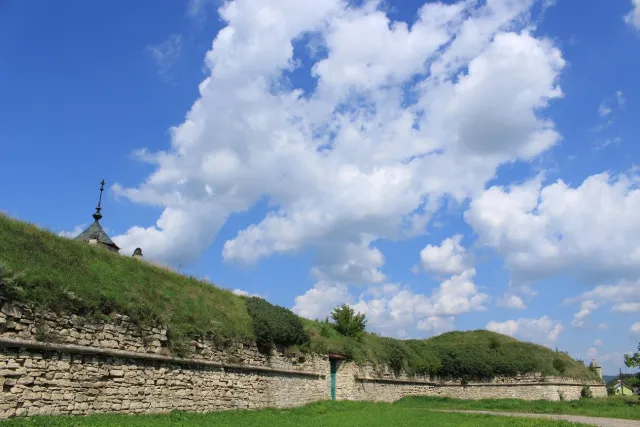
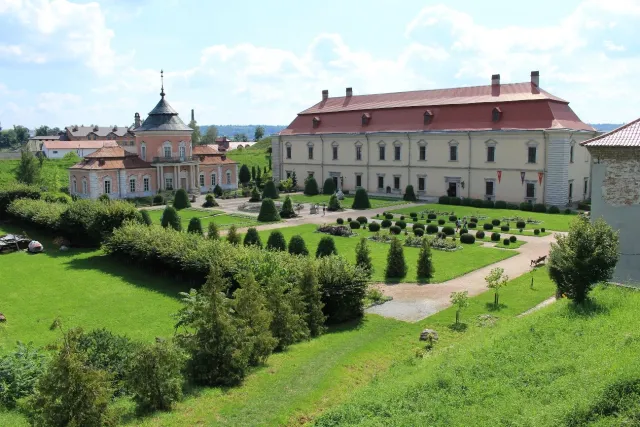
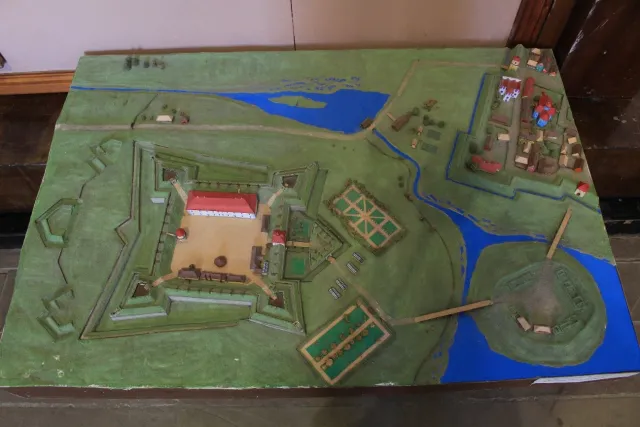
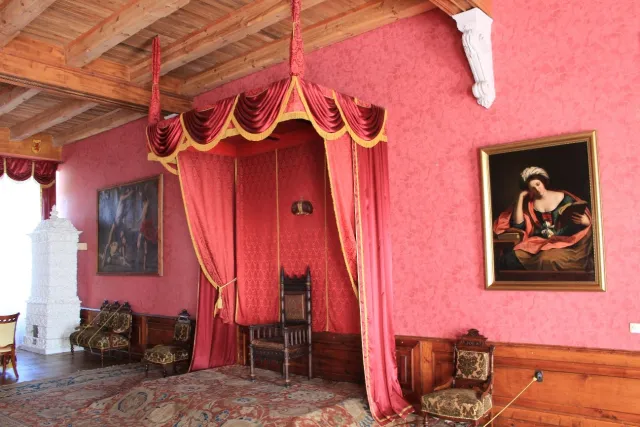
【Getting to Zolochiv】
Zolovich can be found along the train line from Lviv to Kyiv via Ternopil. From Lviv, it takes about one to one and a half hours by regular train. You can also go there by bus if you don’t have any special reason to stop and look at any of the towns and villages along the way (the bus runs directly through the middle of a sunflower field, which is quite spectacular), but I think that train is the better option. Since there are other train stations with the same name, this station is called “Zolochiv” (Злочів). This name is thought to have come from the Polish “Złoczów”.
The station is over 20 minutes south of the castle, and 30 minutes south from the town area. Depending on the time, scheduled buses run from the train station to the bus station in the town center (costing 5 UAH as of August 2018). You can also use the taxis in front of the station. If you walk, you need to head directly north of the station (the station building is out the north exit), and turn right at the main road (Highway M 09). If you turn left on the next northbound street (Markiyana Shashkevycha Street), you will see a beautiful wooden church and a pond. As you pass by a park and approach the center, the sidewalks become neatly interlocked and you will find yourself in a very nice residential area with flower beds and vegetation (similar to the residential area around Tama). Some of the houses in this area date back to before the war (according to the locals these are mostly Polish-era red brick houses). If you turn right at the little park, there is a school on the left-hand side. At the end of this is a restaurant-cum-souvenir shop, and if you walk up the hill next to it you will find the castle entrance. If you want to see the stone walls and moat, you need to go this way. However, you cannot enter the main area of the castle from the back entrance.
The town area is even further north from the castle, and has a few old churches. Buses to and from Lviv can be found in the town from the bus station “Zolochiv-1”. If you turn left after getting off the bus, and head south through the town square and its connecting street, you will find end up by the restaurant-cum-souvenir shop I mentioned above.
According to current schedules, you can easily make a day trip to Zolochiv by departing Lviv around lunchtime on the express train, and returning around 17:45 on the local train. It is a fairly easy tourist attraction to reach from Lviv, so you can even explore a little further while you’re out there.
【References】
Мацюк О. Я. Замки і фортеці Західної України. Мандрівки історичні. Львів: Центр Європи, 2013. С. 30–33.
Палков Т. Західна Україна. Частина II. Львів: Ладекс, 2011. С. 17–21.
Олейнікова Т., Галас Т., Муц Т. Китайський палац у комплексі музею-заповідника «Золочівський замок». Львів: Світ, 2007.
Золочів // Замки і храми України [https://www.castles.com.ua/zolocow.html] (2018年8月5日閲覧、以下同じ).
Історія Золочева // Мандруємо Україною [https://ukrmandry.com.ua/index.php?id=357].
Історія Золочева: легенди та маловідомі факти (郷土史家による解説) // Золочів.нет [https://zolochiv.net/istoriya-zolocheva-lehendy-ta-malovidomi-fakty/].
June Activity Report
30 June 2018
Global Japan Office Coordinator
HARA Masaki
【The 2017 Academic Year Ends】
I went home for a while in May, so this month’s report will skip the time I was away. Anyhow, in Ukraine, the academic year begins in September, and so this month marks the end of the current academic year.
Throughout May and June, many exams were held. I wrote about this before in a previous report, but there are two types of exams in Ukraine; the pass-fail Zalik (Залік), and the 3-level (“excellent, good, pass”) or 5-level (A-E) Ispyt (Іспит) (3-level is the national grading system, 5-level is the international grading system. The failing grades in these systems are known as “fail” or “F” respectively). Failure to pass these exams, and the supplementary exams, is grounds for expulsion. While I think not having the option to repeat a year is very harsh, I suppose it is good in the sense that it encourages students to change their pathways early instead of continuing courses they aren’t really suited for.
Probably the most severe problem for students though, is that their scholarships can be cut off immediately if they receive bad grades. Usually it is too late, so they can’t do anything about it. Bribes are strictly forbidden.
Fourth year undergraduate students have four final exams, which are judged by an examination committee chairman from outside of the university. This year, a professor from the Taras Shevchenko National University of Luhansk filled this role. Since the University of Luhansk is currently being occupied by the Russian military, the people there have been evacuated to Starobilsk, a city in the same Oblast. However, due to restrictions imposed by the so-called “Luhansk People’s Republic” (LNR), many people have been unable to leave Luhansk (the LNR claim that “young people should fight Ukrainian fascists to protect the republic”), and so it seems quite a few students have stayed in Luhansk and are taking classes via correspondence. Master’s students are graded solely on their thesis defense.
When the exam period ends, workshops are held from late June to early July. Some workshops are essentially extensions of classes, and others are educational field trips in which students go around scenic and historic places by bus. I held a critical reading workshop on children’s literature with my third-year students.
After exams, most students are exhausted and go home to get in the summer vacation mood. Incidentally, many students at the University of Lviv come from out of town, and, the other day, when I asked the first-year students in my class where they all came from, most of them were from towns outside of Lviv. There were students who came from towns near Lviv, central Ukraine, and even as far as Donetsk.
April Activity Report
1 May 2018
Global Japan Office Coordinator
HARA Masaki
【The New Semester】
From March, the first year students have been studying their textbooks and reviewing how to write Japanese characters. Japanese characters are usually written from the bottom down and left to right. However, Ukrainian is often written from the bottom up, and the sideways movement varies. Also, in Ukrainian, the end of each character tends to link to the next one as opposed to finishing in a downwards sweep. Because of this, many Ukrainian students tend to write Japanese characters from right to left and bottom to top. For example, they tend to write the top stroke of “u” and “e” last, and make the last stroke on the right side of “ha” flick upwards instead of down (although it seems that even native speakers do this when writing horizontally in a hurry).
Many students think kanji is difficult, but I think even hiragana is a challenge. With hiragana, you have to be able to distinguish between the stops, curls and flicks, and consistently produce flowing strokes. It is very difficult. Because of that, and considering I’m not particularly great at writing myself, I got the students to practice writing Japanese characters through a hiragana review. Looking at the students’ work, it was really obvious that the writing of those who practiced hard had improved drastically. Next time, I want to review hiragana again, and also add katakana into the mix.
In Ukraine, Japanese language education follows a European-esque education system, so I feel that much more focus is put on speaking rather than reading and writing (the majority of teaching materials imported from Japan and used here seem to focus on speaking and spoken Japanese. This of course can change depending on the materials and curriculum textbooks chosen for a class). European languages generally use the same writing systems, so I understand why they focus more on speaking, but if you do the same with Japanese, the students will just end up falling into the opposite of the “I can read but not speak” pattern that native Japanese foreign language learners suffer from. It becomes a problem of students having very “original” illegible handwriting and a very low level of reading comprehension. While you can’t learn to read in a day, writing seems to be an ability that one can grasp relatively quickly, so considerable results like the ones achieved through this review can be expected. Most jobs in Ukraine that are related to Japanese (there are not many) are usually translation jobs. These jobs appear to include translating business terms, documents on imported goods, and instruction manuals. In this case, reading and writing competency is more important than speaking ability.
